#i used to kill my cacti so this is a huge success
Text
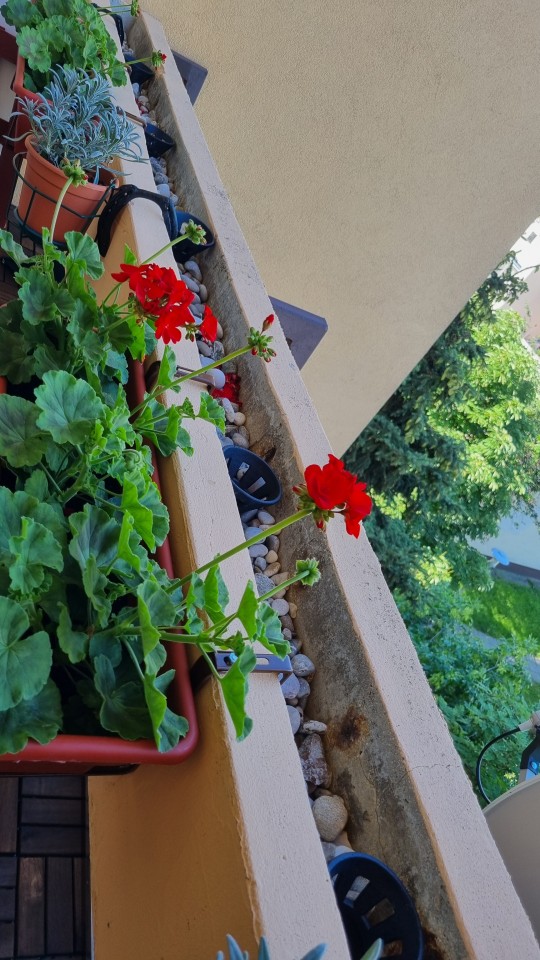

#geranium#lavender#2 months in and they're still alive#thriving even#i used to kill my cacti so this is a huge success
0 notes
Text
P L A N T S - part №1 origins
I've loved plants for a very long time. They've definitely been a huge part of my life since childhood. But since I entered adulthood and started being on my own, I've really made them my own. This year I celebrated the independence of adulthood for 10 years. So I've officially been collecting plants for 10 years! I actually still have my very first cactus. (Its actually on the far right in the photo below. Her name is Blue, because she is a type of Blue Cacti. She's actually doubled in size since this photo.)

I've moved many times and I didn't start accumulating more plants until 2015. After this I actually moved about 10 times until I got to where I am now. For all of that two of my little cacti were all that survived that with me. Most of the times when I moved it was once a year, but sometimes I moved twice. One year I ended up moving a total of 13 times! It was probably one the roughest years I've had in my adult life. It's been 4 years since then, my last move that year was moving back into my family home with my grandparents. I stayed there until I moved to where I am now. That was when I accumulated the bulk of my plants and started doing more with my plant projects and gardening.

(In 2015 in the yard at one of my old homes, I tripped over what I thought was a rock, so I dug it up. I found an old glass bottle containing a naturally formed terrarium with small plants of unknown species.)
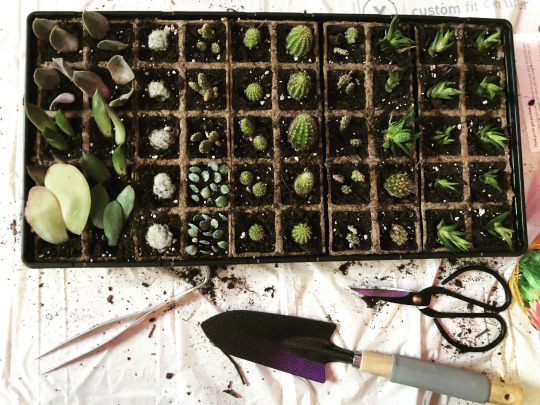
(Photo above is of me trying to root some babies that a bunch of my plants had back in 2019. It was so much work. They all died, literally all of them.)
I've tried propagating cacti and succulents, but have had little success with them. It can be quite a lot of work, just to have them die. It's frustrating. Babies stay on plants until adulthood and even still I've continued to leave them alone out of fear of killing something.
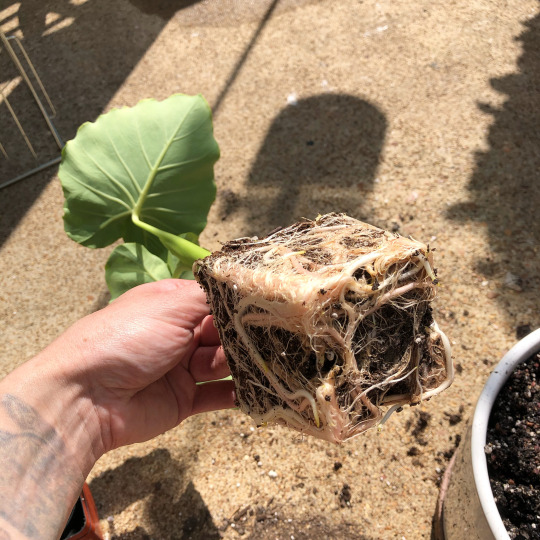
(Photo above is a root bound elephant ear from 2020.)
I've tried plants from bulbs like elephant ears, also with little success. Because they either get root bound or have come down with a mysterious illness. This might also be because I don't have a yard of my own for them.

However I have had lots of other successful endeavors. Like propagation of other types of plants. Like snake plants, avocados, herbs, a fiddle leaf fig, bamboo and more! These are usually things I end up gifting to friends, potting in my own collection, leave them in water, or I trade or sell them. I don't do too much anymore with all of that. Now a days, I usually either repot a rooted prop if it accidentally got torn off the mother plant or just gift it to a friend that has that plant on their wishlist.




(The above photo set is from a trip I took to my local greenhouse back in early 2021.)
Honestly my favorite way to acquire plants is from the local greenhouse. I could spend hours there. It's so magical there and I only live 10 minutes away. Sometimes I think about giving up gardening and just going there anytime I want to enjoy plants. But however that would be a lot of trips to the greenhouse and I don't think I could give up the joy of keeping plants in my house. So I compromise with myself to do a little of both.
Not to mention this greenhouse is in fact the dreamiest one I've ever been to. I would live there if I could. Just put a cozy bed in the back, a small rack of clothes and personal items and I would be living the dream.

(Above photo is of a cart of plants I purchased in my hometown, back in 2019 and no longer own. Two of them died, I had to re-home the fiddle leaf fig because I moved into a smaller apartment a few months after this.)
I have brought home too many plants at times. I've actually had to part with some of them, because I didn't have the proper environment or lighting or room to take care of them. So I actually used to sell them on local and online plant trading groups. I got my collection really refined from doing that and I very carefully choose things to bring home and responsibly give myself an allowance and number of plants I may bring home each greenhouse season. So now I have room for everything I bring home and it must fit a very specific list of requirements. So I don't blow all my money on plants or waste time culling them after I've bought them.
I'm sure at this point you're really excited to see my personal collection. Stay tuned for that in the next post in this series called:
P L A N T S - part №2 collection
#plants#plantcollection#plantcollector#gardening#plantlife#plantblr#plant decor#plantlover#garden#botanical#foliage#cactus#positivity#succulents#plant#greenhouse#greenery#plant parent#indoor garden#motivation
1 note
·
View note
Text
Game 334: Bokosuka Wars (1983)
Bokosuka Wars
Japan
ASCII (developer and publisher)
Released in 1983 for Sharp X1; 1984 for MSX and PC-88; 1985 for FM-7, PC-6001, PC-98, and NES
Date Started: 25 June 2019
Date Finished: 28 June 2019
Total Hours: 6
Difficulty: Hard (4/5), but would probably go down to 3/5 with more experience
Final Rating: (to come later)
Ranking at time of posting: (to come later)
Well, I did it. I downloaded a Nintendo Entertainment System (NES) emulator–Nestopia–and I gave it a shot. It was easier than I expected. I was the thinking that the NES had a directional pad and an analog stick, but I guess that came with later consoles. The original NES controller is little more than a joystick (albeit one that made it harder to move diagonally) with two buttons. Easy to emulate, easy to remember.
Bokosuka Wars was on no one’s list of “must play” console RPGs, but I figured I’d give it a try anyway. It’s the earliest Japanese game on my list that had a western release and the earliest Japanese console game, beating several 1986 titles by a month or so. That it’s not actually an RPG by my definitions (no inventory) shouldn’t bother us too much. It was an easy step into this sub-genre.
A common screen, probably responsible for a lot of the hate the game receives.
The game is an “afternoon RPG,” as any console must be until saving was possible. The setup is simple. You are King Suren, and your country has been overthrown by the evil King Ogreth of the Basam Empire (Ogreth is called “Dragonet” in the original Japanese versions). Ogreth has used his magic to turn all your knights and soldiers into rocks and trees and cacti. You embark on a mission to reclaim your throne. You start 600 meters to the east of King Ogreth’s throne room and slowly make your way left down the battlefield, fighting his forces as you go.
The king starts alone, with 595 steps to his evil counterpart.
You’re not alone in this endeavor. Along the way, you can rescue many of your knights and soldiers. (In the Japanese PC versions, Suren starts with many of his warriors already activated, but in the NES version, he starts alone.) Some are inanimate objects, but they’re revived if you touch them. Others are kept in stockades and must be rescued. Either way, you slowly build (and, just as fast, lose) an army. Eventually, if you survive, you reach Ogreth’s throne room and throw your remaining forces at him, including King Suren if necessary. If any of your units defeat Ogreth, you win the game.
King Suren turns a tree into a knight.
The problem is that you can revive and rescue only 50 warriors (about 15 knights and 35 soldiers), and opposing you are 180 enemies: guards, mages, warriors, and pages. Some of them can be avoided, but most must be fought. Characters move around the battlefield in real-time, but this is in no way an “action RPG.” As frenzied as the game looks, no part of your success depends on your speed with the controller, particularly since enemies cannot attack you and combats are resolved statistically.
The game’s strategy lies in who fights what enemies, and in what circumstances. Your one huge advantage is that enemies can never initiate combat. They can block your way, but combat only begins when you decide to move Suren or one of his warriors to the enemy’s square. Thus, you can almost always choose who fights.
Combat is a probability test that pits your character’s power against the enemy’s, but with a heavy random component. If the die rolls go in your favor, you win; if not, you die. If the character fighting on your side was King Suren, and he dies, the game is over. Winning and losing is completely binary; there are no hit points in the game, so one character can’t “weaken” an enemy for the next character.
My king battles a “summoner” in the middle of his spirits. Since my king has 320 power and the summoner only has 50, I’m relatively confident. During battle , the tile flashes between crossed swords and “B.” I’m not sure what the “B” means, but it doesn’t have anything to do with the “B” button on the controller. Maybe it means “Bokosuka.”
If you win, the winning unit gets an increase in power–sometimes substantial. For instance, soldiers start at a power of 30 and rise to 40 and 50 with their first two victories. But if they achieve a third victory, they change color and rise to 140. Knights do the same thing, with the progression going 150, 160, 170 and then jumping to 260 on the third victory.
Note that one of my knights and one soldier have “gone gold,” making them more powerful than their counterparts. A knight is needed to bust through the shield around the stockade.
King Suren himself starts at 220 and maxes at 320; soldiers and knights max at 310. Throughout the game, you have to keep making the decision about whether to throw your more powerful figures into combat, thus risking them, or try to build up weaker units. There’s no easy answer. And occasionally even the most disproportionate combats can go wrong. I saw plenty of knights at 310 power killed by enemies at 10 power.
Enemy and ally unit powers. This is from the Sharp X1 version. NES players had to read the manual.
There are a few other tactical considerations. Regular soldiers (for some reason) knock enemy guards from 100 power to 10 power when they engage in combat. Knights are the only units that can break the walls of stockades, so you want to keep at least one around. You need soldiers to disarm traps (which don’t appear until after your first victory). Only the king can trigger special squares that remove the walls blocking “summoners,” who then summon a bunch of spirits (which don’t count against the enemy’s total) until you kill the summoners.
Every once in a while, the king runs out of soldiers and stands alone.
I suspect the game would be “easy” for those with a lot of patience. One key problem is the movement of your forces. By default everyone moves together when you press the directional pad; if they’re up against an obstacle, they just stay in place. You can toggle so that you’re only selecting one type of unit at a time (i.e., the king, all soldiers, or all knights), but it’s still tough to move them in unison, and I probably left more allies stuck on obstacles behind me than I lost in combat. This problem is the source of a lot of modern complaints about the game, I later found, but I think it added somewhat to the game’s strategy. When you have a lot of units in your army, you have to be careful about every move, noting who is going to end up in what square, and thus what units will find themselves in combat. A player who develops a huge army is handicapped by having to more carefully manage its movement. I can’t claim that I exactly “enjoyed” such a gameplay element, but that doesn’t make it inherently bad.
Moving through terrain like this is easier when you only control one unit “type” at a time.
You don’t have to fight every battle. In fact, there’s a good argument to be made in fighting as few as possible, thus reaching the end of the game with as many forces as possible. On the other hand, it helps if those forces have gained a lot of experience along the way, so you don’t want to eschew every combat. It’s a tough call.
Having broken a bunch of soldiers out of a stockade, now approaching a phalanx of guards. To get the soldiers out of their building, I’m going to have to move everybody back and up a few spaces.
You eventually reach a point where you have to thread a narrow hallway to get to the throne room, which features a number of unavoidable battles with “killers” with 250 power. Even though you might have more than 300 power at this point, the killers seem to win more than half the time. The same is true for King Ogreth himself, who only has 250 power but seems to beat 300+-power allies at least three-quarters of the time. So whether you win or lose upon reaching the end is largely a matter of whether you have enough allies to overwhelm the probabilities of losing individual combats. You definitely don’t want it to come down to King Ogreth vs. King Suren.
Reaching the final throne room. Looks like I’ll have to take out a summoner before engaging the king. I only have three (promoted) units with me, but there are 10 more somewhere behind me if I didn’t want to risk Suren in the final battle.
A good opening strategy is to have Suren fight all the combats until he gets to his maximum power of 320. If he’s going to die, better it happens in the opening few minutes than hundreds of meters down the battlefield. After that, I tended to prioritize building weaker units than risking more experienced ones. That had the effect of keeping my numbers small but my individual units powerful. However, I’m sure there are several strategies that would work. I’m sure it’s possible to have King Suren charge down the battlefield alone, fighting only the necessary combats (i.e., when an enemy is blocking you and there’s nowhere to go), and make it all the way to the end. I tried it and made it to about the 300-yard line–halfway through the game–before I was overwhelmed by a group of knights and ultimately killed. Some other player makes that strategy work in this video, winning the game in just under 5 minutes, but there’s a note that the session somehow “manipulates luck,” so I’m not sure if it’s an honest win.
A winning game takes about an hour, taking modest care, and perhaps two hours being extra careful. If you win you get a nice screen and then an invitation to try again. Small squares in the upper-right corner keep track of your victories. The only thing different about subsequent loops is that they feature traps that kill you instantly unless a soldier walks over them. Apparently, you face more traps the more previous victories you have under your belt.
An angry King Suren chases his enemies off screen.
The game scores poorly as an RPG, getting only 15 points on the GIMLET, nothing rating higher than a 2, with 0s in economy and equipment. Nonetheless, it was enjoyable for a few hours as I tried to figure out the right strategies, watched the odometer count down my distance to Ogreth, and held my breath every time Suren entered combat. I lost 8 times–twice in the last 100 meters–and I suppose I would feel differently about the game if that had continued much longer.
The box captures the somewhat linear nature of the game.
Given my generally positive feelings, I was surprised when I started doing my post-game research and saw Bokosuka Wars repeatedly referred to as the worst game ever made for the NES, with multiple sites calling it completely impossible. Granted, PC games were significantly ahead of the experience that Bokosuka Wars could provide, but even console-only players seem to love to trash this title. I suspect what’s happening here is that RPG-oriented players want their success determined by statistics that they can manage, and arcade-oriented players want their fate decided by their own dexterity. A game that’s so heavily based on random probability serves neither group. Nonetheless, I had fun with it. It showed me an approach to gameplay I haven’t experienced before. I wouldn’t want every game to take its mechanics from Bokosuka Wars, but as a one time experience, it was fine.
(Believe me, I appreciate the irony of me, who never heard of this game two weeks ago, who resisted the console sub-genre for a decade, suddenly mounting an impassioned defense of the first console RPG that I played.)
The Sharp XI version starts the king with a large army.
As poorly as the game was apparently received, it is credited in many sources in laying the foundations for the tactical RPG genre in Japan. I’ll reserve judgement on that until I actual play more tactical RPGs. In a funny footnote, Bokosuka Wars II was released for the PlayStation 4 in 2017. (There’s a so-called sequel called New Bokosuka Wars for the Sharp X1 alone in 1984, but I really think it’s just another version of the original game.) That gap of 33 years must be one of the longest between an original game and its sequel in gaming history, although Bethesda seems determined to beat it.
I’m disappointed that the game didn’t explain what bokosuka meant. Does anyone know? Googling provides mostly this game and a VR game called Bokosuka Girls. I’m trying to think what adjective could apply to both wars and buxom women and I’m coming up short.
source http://reposts.ciathyza.com/game-334-bokosuka-wars-1983/
1 note
·
View note
Text
sense of community in tabletop rpgs
I was talking today with a friend about how cool the sense of community was in recent shadowrun crpgs, and I remembered how much I loved doing communities when I was running tabletop games, so I decided to write down the principles I used, mostly out of nostalgia, but maybe it’ll give someone ideas.
Communities are a great way to make players emotionally invested and do it *stealthily*, without them seeming it coming, so when you do a sneak attack of feels, it hits them hardest. The easiest way to establish the sense of community in your game, of course, requires your party to have a homebase where they return each time after an adventure. There are ways to manage it without homebase, but lets see the easiest route at first.
Homebase. It’s better to make homebase somehow interesting, to give it a distinguishing feature that immediately sticks out when you think of this place. It’s an advice not just for homebases, but for making locations in general. It can be geographical, like a city on the hills near a volcano, or cultural, like a city of demons exiled from hell, or even purely decorative, like a city that is covered in cacti. Cactus all over the place! It’s important to not overload players with these features and lore for them, though. Even if you’ve written 20 pages of deep intricate history and politics and cultural background for the place, don’t just pour it on players in one go. Ease it out on them gradually, otherwise it all will blur together into a confused mess. When I establish new location, I make sure to give players no more than three features, which could be all explained with ONE string of logic and theme. Frex, a town was built on the slopes of a volcano by demons exiled from hell, because they wanted an environment closest to their lava-filled motherland. They also brought a special sort of cactus from hell, because it reminds them of home. The unifying theme there is Nostalgia for Hell.
Center of community. Next thing to establish is the social circle that the party will be interested in participating. The thing is, it’s gotta be hugely beneficial for them or the penalties for not engaging in that circle should be substantial. It’s because normally players will not go out of their way to engage like that socially without you basically forcing them.
For example, in one campaign that social circle was a guild of bounty hunters. Location-wise, it was a big tavern run by a druid and a former monster hunter who had a pet basilisk. So this tavern was decorated by the statues of various cool monsters, who were actually real monsters turned to stone. It was basically a hub for mercenary crews to get contracts. Players had to get involved, because otherwise they’ll get no quests.
Activities. Make sure your community has interesting activities, and I don’t mean that one festival fair that you did in a “filler episode.” Repeated structured interactions with NPCs are the key to players emotionally engaging and feeling like this place is a “home.” In my bounty hunters guild, there were ranks for the crews to climb to get better contracts with bigger rewards. You got points for how fast you did the quest, how many monsters you killed, how successful you were, and so on. So when the players were getting there to get reward for quests, they were enthusiastically describing all cool shit they did to get more points, and other crews were chiming in and that’s how the community was engaged. There were also auctions, where crews would bet for special high-reward contracts, and other stuff that players could engage with.
Don’t let these interactions to turn into an automatized script, make them roleplay it. By that I mean don’t let them just go “I walk into a tavern and ask for quest”. Make different little scenes every time. Party walks into a bounty hunting guild and here are the Skullsuckers in a brawl with Fluffbums. Are players gonna try to stop them or get in into the brawl? Don’t let them ignore it either. If they do nothing, they get hit with a flying beer cask, the chandelier falls, etc. It gives your community life, a bit of new flavor to each interaction. It also helps with the pacing, because if you run players at high speed of long action->5 minutes of shopping and rest -> long action again, they’re gonna be exhausted.
Sub-groups. In best case scenario you should be able to separate the community into little groups, kind of sub-factions. In bounty hunters guild it happened naturally, by the virtue of mercenaries already running in crews. Then you should give them some personal flavors - at first, one flavor per group, like mass effect races, - and establish some relationship between each other. Keep it real simple at first. These are Skullsuckers, they like to suck skulls. These are Fluffbums, they have fluffy bums. Skullsuckers are feudng with Fluffbums, because Fluffbums sometimes sit on skulls that Skullsuckers leave all over the place, and Skullsuckers hate it, because sucking skulls covered in fur is gross.
After first couple interactions you could see who your players are most interested in and then develop these groups with more details. Don’t do it before you’re sure these details will actually come up, because if you give every Skullsucker an intricate backstory, but your players are stubbornly hanging out with Fluffbums, it’s gonna be waste of time and effort and you’ll feel mad at players for not appreciating your ~art.~
Politics and drama. Your groups should infuse your activities with emotional stakes. Skullsuckers got your party’s contract and laughed in their face! Fluffbums provided them with tips and tricks to handle a particular monster! Two small groups united to out-bet the snobbish trust-fund palandins! I think this is pretty easy to do if you have a handle of your groups and your activities, you just gotta watch who your players like or hate and play the situations up to give them narratives in a framework of these activities.
NPCs. Last, but not least level is inter-personal relationships between players and NPCs. All players want the spotlight, but they usually don’t give it to each other. It’s basically a troop of several divas, all craving for attention. So you give your player an NPC who’s genuinely interested in their character as a person and wants to hear all cool stuff that happened to them.

Yeah, that caring what player has to say is SUPER effective in getting them emotionally invested in NPC. It’s actually scarily effective, one time I had a player who wanted to romance a talking garden gnome bc of that, which I certainly didn’t plan for.
Don’t push it though, start casual, don’t try to jump into soul-searching conversations right away. And instead of trying to design NPC to “seduce” a specific player, it’s better to get an idea for interesting NPC and let one of the players to take a bait. When you see who’s interested, you can develop it from here, and it will feel much more natural for the player, because from their perspective it was *their* choice to engage.
In the first evening of my party in the bounty hunters guild, they were getting picked on as rookies - standard practice in this type of environment. There was a particularly sharp-tongued leader of the rival group who was making fun of the party. I kept an eye on which of my players takes the bait - responds to him the most, - saw that it’s the cleric, and had them have a little short banter. Next time the party is in the guild and bragging about what dangers they bested for points, that guy is making witty comments again, but more directly addressing the cleric. Third time, they talk in private, still half-bragging half-mocking, but with more detailed emotions described. Like, the cleric says that they killed the red dragon and the rival is genuinely impressed. He tries to hide it, jokes that “well if you incompetent rookies managed to kill him, it was probably the weakest dragon in a world!,” but the player can tell he really thinks it’s cool. That’s it - next time the part is in town, the cleric is going to deliberately seek out the rival. Then it progresses naturally in “slowburn, enemies to friends to lovers, 75k” format. It’s important to keep your NPCs reactive to what players are doing. If players are late from contract, on their way back they meet that rival’s group, because he was worried and went to help, and so on.
You know your player is hooked when after something important or cool happens, they go “I can’t wait to tell it to NPC!” Then you can arrange your dramatic payoff, like raising the stakes or making a hard decision. In bounty hunters campaign, the main quest of this party revolved around some sort of invasion from another dimension that was prophesied for specific time, because stars will align or some shit. Then in like 4 days before that date, the rival’s group gets in trouble on their contract - captured by devils or whatnot. Theoretically, the party has just barely enough time to go save them and get back in time for invasion, but it’s a huge risk. Do they leave the rival to die or try to save him and risk the fate of the whole world? The drama! The emotions! The nerves! The tension! Players yell at me and each other!
They go and save him, of course, and then they race back, but they don’t have to to prepare and rest fully, so they are desperate and think they’re going to lose. And then the entire guild shows up to help them, because the saved rival told them what happens and they all like our party. Even Skullsuckers are there! I cannot overstate how important moments like these feel for the players - after doing lots of little side-quests and regulating conflicts and establishing relationships, when this investment pays off, it’s cathartic. It’s moments like this when you make your players feel that everything they did mattered. Especially if they are at the low point and facing terrible odds, so that pay off is not decorative, but functional. Riding that wave, you can make any cheesy speech from guild leader about being a family and belonging and I guarantee you at least one player gonna tear up. It still was a hard fight for a party, but it was a very different emotional context. The party now felt like they had their backs covered, like they are part of the bigger whole, and that’s what a sense of community is ultimately about.
#the mercenary crew wasnt actually called Skullsuckers in my real campaign#but it should have been#dnd#meta#dungeons and dragons
154 notes
·
View notes
Photo

Oh, My Bleeding Heart!
"How long before Mom kills this one?” my children predict, more than ask, every time I bring home a plant. My husband and daughter-in-law chime in their agreement.
I laugh to myself. I’m not sure that it matters, as plants are cheap. Their survival is not as important as the colour and design of the pots, the contours of the leaf shapes, and the vibrancy of the flower hues - in the rare event that one of my plants actually blooms. If one dies, I replace it as I would a broken dish.

I am not attached to plants like my house cleaner, Angelica. She talks to my plant victims and apologizes for my neglect. If a plant is unresponsive or dying, I give it to her. After a few weeks, she shows me pictures of the now-humongous plant with gorgeous blooms. Oh well, I think. The plant would not fit in its pot, anyway.
When my daughter, Julia, was growing up, I would let her pick out plants for her room. Under my tutelage, she would choose one for its visual attractiveness and how it would match the room colour. If the plant died, I just bought her a new cheap one, always of the smallest size, since my budget had to withstand many plant purchases.
Julia now has her own home and has discovered that her mother never knew anything about horticulture. Ruth, my son-in-law's mother, has blown my cover. She is teaching my daughter to consider such boring factors as the type of soil, time and quantity of sunlight, and when and how to water the plant. Apparently, even the pot size matters.
Too many things to think about, in my opinion. It is so much easier to just consider how the plant foliage will look next to the colour of the pot.

No wonder none of my plants survived. I placed them in rooms where they looked best and didn't worry about sunlight. I gave them a good dousing when I thought of it or happened to notice their wilted appearance. Unfortunately, I often forgot to look, especially during the first three months of my pregnancies when I absolutely did not think about feeding greenery when I myself could barely drink tea or eat crackers. All plants needed replacing.
When we moved to our current residence, I decided to cease my growing efforts. I gave all of my plants to Angelica and successfully kept my house plant-free for over a year. Then I read on facebook that we would sleep better if we had certain oxygen-emitting plants in our bedroom.
I dutifully traipsed off to Rona to buy these supposedly insomnia-healing plants. The clerk, probably thinking that I had failed high school biology, patiently explained to me that ALL plants give out oxygen, not just the five facebook recommends. But I persisted, and purchased four of the five suggested specimens - with plant pots to match. I resisted the rest of the colourful displays until a cute cactus with bright yellow blooms caught my eye, reminding me of my father's love for both cacti and the colour yellow. Four plants became five.

My family did not admire the plants, not even the sentimental purchase, but rather engaged in another round of mockery in the game of How Long Will These Last? They did not have to wait long, for one soon to show signs of dying.

For Mother's Day, my daughter offered to help me weed and plant the small flowerbed under my front window. I politely tried to distract her from this line of thought, hoping to avoid another plant disaster, but she persisted. I finally gave in, knowing that I needed help, given my questionable skill level with dirt and living plant organisms.
My artistic side wanted to immediately shop for new plants, but Julia wisely insisted that we needed to weed first.
The flower bed was a disaster, in the same state as when we purchased the house.
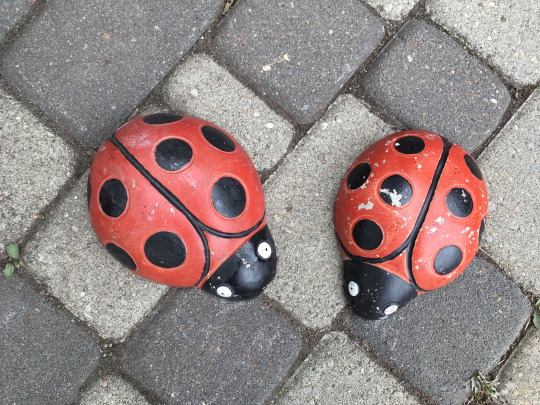
Two huge rocks, a profusion of weeds, two stone ladybugs, renamed Poop by my grandson, and one lone plant, awkardly placed - a bleeding heart.
Amazingly, I actually knew the name of this plant. My grandmother, Julia, (also my daughter's namesake), grew this perennial. I remember her telling me the legend of the bleeding heart as she pulled the flower apart, showing me the bunnies, earrings, slippers, sword, and stabbed heart. I will forever treasure the precious times sitting beside my grandmother, feeling her love and affirmation in those suspended-in-time moments, as she retold the same story over and over.

For those memories, I had to keep this plant and so ruthlessly transplanted it to a better spot,
figuring that any plant called a bleeding heart could survive being cut off at the roots.
My daughter does not think it will survive, but if it is still alive next summer, she will buy me dinner.
As usual, most of the remaining plant choices were for their design and colour scheme of white, pink, and periwinkle blue with a splash of yellow.

Some made the cut for sentimental reasons.

Spirea
I partially chose this shrub as I had grown it with modest success in a more northern climate, but mostly because it reminded me of my wonderful Aunty Betty who once had a lovely profusion of spireas by her front walkway.

Silver Mound
My cousin, Sherry, is a successful gardener, despite our shared gene pool. Ever since she told me how much she loved her Silver Mound, I try to plant one everywhere I live. She told me that no matter how you damage it, it will always grow back to a round shape. We'll see. My daughter is doubtful.

Jack Frost, but I call it a Forget-Me-Not
As I recall, my Dad loved forget-me-nots. My Mom had a forget-me-not china tea set - because Dad liked them, she told me. In any case, I like the periwinkle flowers, and will think of my father every time I look at them.

Nameless Plant - My Substitute Rose Bush
For my father, who loved yellow roses
Actually, yellow was the only colour he could easily recognize, due to his colour blindness. He failed Kindergarten because he coloured tree branches brown and tree trunks green. Too bad the teacher did not notice that his suns were always coloured yellow.
A few years before he died, he commented that he recognized how much I loved colour: this meant a lot to me, since he saw colours differently than most. He deserves yellow flowers in his honour.
For my mother, who loved roses, especially red ones, and could grow them anywhere
I admit, the flowers are not red, and they are not roses, but I am not foolish enough to attempt to grow roses - of any colour. The yellow flowers on the nameless pseudo-rose plant will have to do as stand-ins for red in honour of my mom.
It was a good day.

My daughter and I bumbled along together, guessing at how deep to dig the holes, how much water to use, and how to follow the instructions to massage the roots. With high hopes for success, we randomly sprinkled bone meal and mixed soils with varying degrees of proportion.
I named the first two shrubs Betty and Betsy. My daughter said that I couldn’t use alliteration and so named the third Caroline.
Mostly, we giggled at my lack of skill and knowledge. She laughed when I told her that I had considered marrying a farmer and that a higher power had saved me from such a disaster, knowing that I would be better suited to managing unruly students in a classroom than rampant weeds in a vegetable garden. My daughter said she was happy for the said farmer.
We laughed as we threw newspaper on the ground and covered it with mulch because the internet said we could. We disagreed amicably and proudly viewed our work.


Not all of our days have been so.
Somewhere, starting in the preteen years, the arguments outnumbered the good times.
Pictures of family events do not always evoke pleasant memories.
Thankfully, my daughter and I are finding a new rhythm in our relationship.
Hurting hearts lie mostly buried and new growth is emerging as we share experiences of marriage and motherhood,
preferring the safety of common ground to unpacking potentially explosive landmines of the past.
New pictures of family are emerging...

My daughter and I in front of my new beautiful flower bed with all of its colour and variegated foliage.
I treasure the memories this day symbolizes, of easy mother-daughter banter and the sounds of Julia singing “Sweet Caroline”.
Other Thoughtful and Symbolical Mother's Day Gifts from my Family...

A hand-carved wooden spoon made by my son-in-law, Jeremy @Lotholz and Company

Multi-coloured daisies from my husband, Cliff, each colour representing a different season in our marriage.
His message in my Mother's Day card was appropriate for this as yet unwritten article: You ground me.

An African Violet from my daughter-in-law, Breanna, displayed on my Grandma Ida's sewing machine, well-used in days gone by. Breanna had no idea how much my mother loved African Violets.
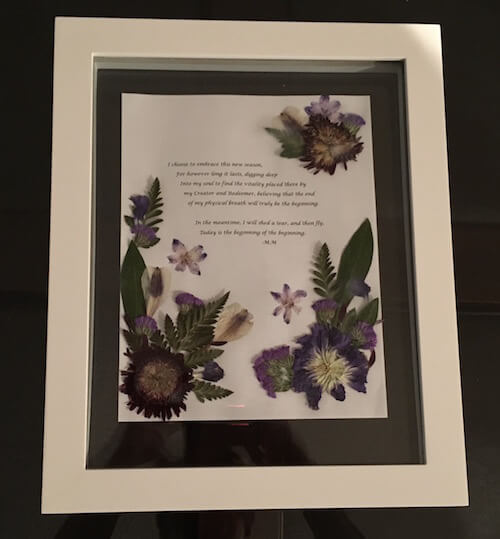
A framed picture from my son, Stephen, and his wife, Breanna.
To make this beautiful keepsake, Breanna used dried flowers from a birthday bouquet from my siblings and a quote from my blog.
My son, Stephen, and I are taking our relationship to a new level as he repairs our basement and edits my blog.
Grandchildren...sharing the scents and blooms of the fresh growth.
I am grateful for the opportunity for forming new family relationships.

A red rose bush from my son, Michael, in honour of his grandmother and me, his mother.
My relationship with my son, Michael, is marked by elements of unpredictability and the unexpected.
Once, before he could even talk, I asked him for a kiss, but he kissed the wall instead.
I love the times when he surprises me with a symphony concert or a rafting trip.
Today, as I watch him plant the roses, I celebrate the past, present, and future of family.
While I wonder how to cope with the inescapable challenge of growing these red blooms, I embrace the pain and struggle of nurturing both roses and relationships.
Meanwhile, the jury is still out on the bleeding heart's survival,but it is showing new buds and flowers, boding well for the future.

Perhaps human bleeding hearts can also survive - and even bloom.
POSTSCRIPT
I just saw a facebook post about six plants that repel mosquitoes.
Tempting..
Previously published on https:www.marilynnewbury.com
0 notes